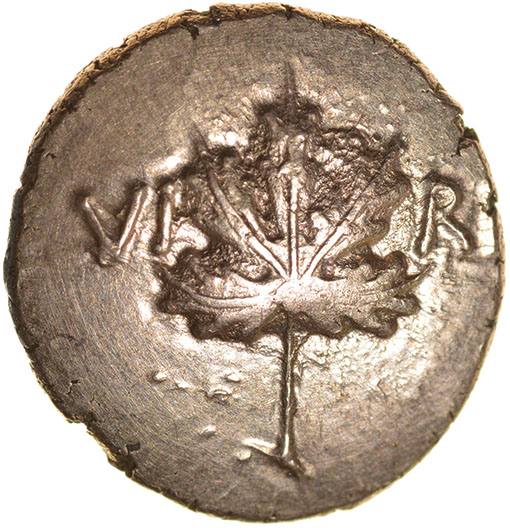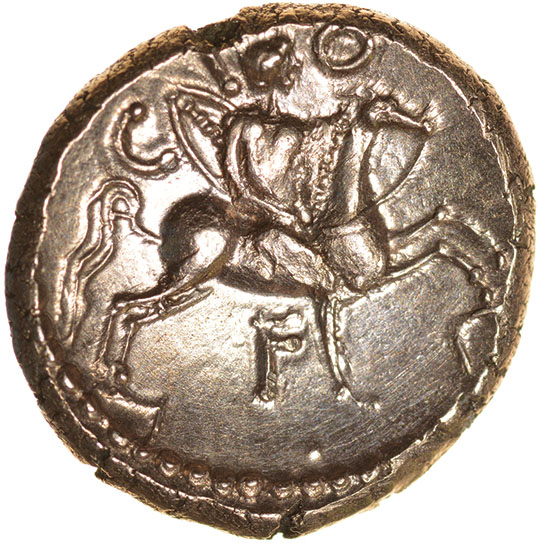8
Verica Vine Leaf. Leaping Horse Type with Triple Tail. c.AD10-40. Celtic gold stater. 17mm. 5.34g.
Verica Vine Leaf. Leaping Horse Type with Triple Stranded Tail. Sills class 5c, dies 19/35. c.AD10-40. Gold stater. 17mm. 5.34g. Centrally positioned vine leaf on plain field, VI to left, R[I] to right./ Cavalryman mounted on a right-facing horse with beaded mane, bridle rein and triple-stranded tail, CO F around, beaded border. Apart from his bowl-shaped helmet, the horseman appears to be naked and riding bareback; an elliptical shield with a vertical beaded line and what looks like a ?javelin, are slung over his left shoulder. The horse’s forelegs and hindlegs are precariously perched on two inward-tilting angles, seemingly bridging a chasm and giving the horseman an almost statuesque quality, frozen in action in a moment of time. ABC−, VA 520-5, BMC 1168-74, DK 367 (text), S–.CCI 15.0535 (this coin). Good EF, virtually as minted, lustrous rose gold with absolutely unblemished satin-like surfaces, complete vine leaf centrally situated, magnificent parade-style horseman, crisply cut inscription. An exceptionally elegant example, possibly the finest we’ve had of this fascinating Leaping Horse Type. A well documented pedigree piece from the celebrated Celtic collection of Geoff Cottam, Spink 232, 2 December 2015, lot 150; ex Classical Numismatic Group 10 October 1999. RARE type with triple stranded tail, only 44 others recorded including 15 in museums.
Historically this is a significant specimen of the Leaping Horse Type because both right-angle plinths can be clearly seen and because, with equal clarity, the plinths were placed there for a purpose. Over the last seventeen years we have speculated as to what purpose King Verica and his engraver may have had in mind. In 2002 we said: “The statuesque setting for the horseman is undoubtedly deliberate, placing him literally on a pedestal; which leads me to believe that he may be intended to be viewed as Verica himself, or his revered ancestor, Commios. An alternative reading of the image might be that the cavalryman is jumping over a chasm or – even more fanciful – that Verica bridges the time-gap between Commios and himself, and that he may therefore be seen as a worthy successor to the Atrebatic throne.” In 2016 we sold a Leaping Horse stater which had cross-hatched plinths (same dies as BMC 1167), saying: “The two cross-hatched mounts might also be seen as two pieces of land – Atrebatic and Regnan? British and Gaul? – which are bridged by the powerful, unifying, cross-channel-trading Verica.” Dr John Sills says the Leaping Horse Type “is so named from the unusual attitude of the horse, which is shown leaping from one square embankment to another. It may represent the king straddling the northern and southern halves of his territory, portray a particular event in his reign, or simply be a die-cutter’s whim” (DK, 2017 , p.379). Today we feel the most plausible interpretation of the two plinths is that Verica has united the two halves of the southern kingdom (Atrebatic and Regnan), previously split between Tincomarus and Eppillus. The sensational, near mint-state condition of Geoff Cottam’s stunning stater suggests that it may have come from a hoard, perhaps from the Burchett’s Green hoard, Berkshire, 1991? See Coin News, April 2016, p.36.
Verica Vine Leaf. Leaping Horse Type with Triple Stranded Tail. Sills class 5c, dies 19/35. c.AD10-40. Gold stater. 17mm. 5.34g. Centrally positioned vine leaf on plain field, VI to left, R[I] to right./ Cavalryman mounted on a right-facing horse with beaded mane, bridle rein and triple-stranded tail, CO F around, beaded border. Apart from his bowl-shaped helmet, the horseman appears to be naked and riding bareback; an elliptical shield with a vertical beaded line and what looks like a ?javelin, are slung over his left shoulder. The horse’s forelegs and hindlegs are precariously perched on two inward-tilting angles, seemingly bridging a chasm and giving the horseman an almost statuesque quality, frozen in action in a moment of time. ABC−, VA 520-5, BMC 1168-74, DK 367 (text), S–.CCI 15.0535 (this coin). Good EF, virtually as minted, lustrous rose gold with absolutely unblemished satin-like surfaces, complete vine leaf centrally situated, magnificent parade-style horseman, crisply cut inscription. An exceptionally elegant example, possibly the finest we’ve had of this fascinating Leaping Horse Type. A well documented pedigree piece from the celebrated Celtic collection of Geoff Cottam, Spink 232, 2 December 2015, lot 150; ex Classical Numismatic Group 10 October 1999. RARE type with triple stranded tail, only 44 others recorded including 15 in museums.
Historically this is a significant specimen of the Leaping Horse Type because both right-angle plinths can be clearly seen and because, with equal clarity, the plinths were placed there for a purpose. Over the last seventeen years we have speculated as to what purpose King Verica and his engraver may have had in mind. In 2002 we said: “The statuesque setting for the horseman is undoubtedly deliberate, placing him literally on a pedestal; which leads me to believe that he may be intended to be viewed as Verica himself, or his revered ancestor, Commios. An alternative reading of the image might be that the cavalryman is jumping over a chasm or – even more fanciful – that Verica bridges the time-gap between Commios and himself, and that he may therefore be seen as a worthy successor to the Atrebatic throne.” In 2016 we sold a Leaping Horse stater which had cross-hatched plinths (same dies as BMC 1167), saying: “The two cross-hatched mounts might also be seen as two pieces of land – Atrebatic and Regnan? British and Gaul? – which are bridged by the powerful, unifying, cross-channel-trading Verica.” Dr John Sills says the Leaping Horse Type “is so named from the unusual attitude of the horse, which is shown leaping from one square embankment to another. It may represent the king straddling the northern and southern halves of his territory, portray a particular event in his reign, or simply be a die-cutter’s whim” (DK, 2017 , p.379). Today we feel the most plausible interpretation of the two plinths is that Verica has united the two halves of the southern kingdom (Atrebatic and Regnan), previously split between Tincomarus and Eppillus. The sensational, near mint-state condition of Geoff Cottam’s stunning stater suggests that it may have come from a hoard, perhaps from the Burchett’s Green hoard, Berkshire, 1991? See Coin News, April 2016, p.36.
Chris Rudd Auction 167
Ends from
Venue Address
General delivery information available from the auctioneer
Postage & packing will be added to all invoices. Unless specified otherwise all UK orders sent by Special Delivery. Orders up to £1000 cost £15, over £1000 cost £20. European orders sent International Signed For delivery £15, USA/Canada £25, Rest of World £20.
Important Information
Please read our terms and conditions before bidding.
Terms & Conditions
Terms & Conditions for Chris Rudd Auctions
These terms are summarised. Liz will be happy to answer any questions you may have. Please email liz@celticcoins.com or phone 01263 735 007 or 07990 840 816.
Our estimated value of each lot is given in the catalogue and online. Bidding starts at 80% of this estimate. Estimates shown in BLACK, Starting Prices shown in RED.
How to bid via Internet.Our Auction is conducted online via www.the-saleroom.com If you wish to bid you must ‘Create an account’ and you will receive an email link confirmation of Registration. This must be activated prior to bidding. You must register to bid for each auction. If you are a new bidder in our sale, please provide numismatic credit references and credit/debit card details to secure any bids you may place. Client data is confidential; we do not share our mailing list or client information unless authorised. We reserve the right to revoke any bids and registrations, restrict accesses, and modify or disable the site or any of its features, at our discretion. We do not make any guarantees regarding accessibility, accuracy, or security of this website with regard to registration of bidding. All financial transactions will be carried out by ourselves, the-saleroom.com requests card information for security reasons and will not debit your card.
How to bid by phone, fax or email. In addition to internet bidding, you may bid by mailing the bid sheet included with each catalogue, or by email, fax or telephone. If you choose to telephone your bids, we appreciate a written follow-up. Bids must be received by 12 midday (UK time) Friday 15 November, after this time we cannot guarantee that bids will be placed. If you wish for any guidance regarding current bids please contact Liz. Online bidding continues until the lot closes at 5pm (UK time) Sunday 17 November.
Bidding increments. Lots will be sold to the highest bidder for the winning bid. Bidding automatically increases in fixed increments, so you can enter your maximum bid and let our system do the bidding for you. Please ensure your bids comply with the steps outlined below:
Up to £500 in £20 increments
£500-£1000 in £50 increments
£1000-£2000 in £100 increments
£2000-£5000 in £200 increments
Over £5000 in £500 increments
If you enter a high maximum bid you will win at the current bid amount plus increment. Whole number bids only. Bidders personally guarantee that they will pay for their winning bids.
The first lot will close electronically at 5pm (UK time) on the sale date, with subsequent lots closing every 30 seconds thereafter. Please note: Sniper bids are not allowed. If you bid within the last 10 minutes the lot closing the time will extend by 10 minutes on that lot, from the time of bid.
Personal viewing of lots by appointment only. Please contact Liz to arrange.
How to pay. A 20% buyers fee (24% inc. VAT if applicable at the current rate), will be added to the hammer price of all successful online, written, fax, email and phone bids. Bids are placed in GB£ Sterling. Payment is preferred by direct transfer in £ Sterling (GB£): Chris Rudd Ltd Account Number: 63406857, Sort Code: 20-03-26 or by cheque, postal orders, cash (GB£). Or by International bank transfer to Barclays Bank PLC, Market Place, Aylsham, Norfolk NR11 6EW. IBAN: GB14 BARC 2003 2663 4068 57. SWIFTBIC: BARCGB22. Please ensure all charges are paid or add £6 to cover EU charges, £12 International charges. Visa, MasterCard or debit card accepted. We also accept US$ cheques with $25 bank fee added. Goods remain our property until paid in full. VAT no. GB 665532227.
Winning lots will be sent as soon as possible after receipt of payment on seven days approval. If you aren’t happy with a coin, please phone before returning it. Prices realised are available by subscription via the-saleroom.com
Postage & packing will be added to all invoices. Unless specified otherwise all UK orders under £50 sent first class £1, orders between £51-£99 sent Signed For Delivery £3, orders over £100 sent by Special Delivery £10. All overseas orders under £100 sent uninsured (at your risk) £6. European orders over £100 sent International Signed For delivery £15, Rest of World £20.
Privacy Your details are securely held and will not be shared. They will be retained for processing orders and marketing. Please let us know if you don’t wish to be contacted. You can do this at any time.
Export licences are needed for some coins and can take 4-6 weeks to get. Their purpose is to curb the export of national treasures.






